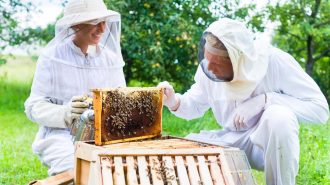July is when the beekeeping program begins for beekeeping and we begin to prepare our bees for fall and winter. Nucs, packages, and established hives have one thing in common…. In July of a normal year, the nectar flow has either stopped or is dwindling in our area. There are some small nectar flows which will continue into fall but they do not provide enough nutrients for bees and encourage continued brood rearing. Exceptions are hives that are near late blooming crops such as alfalfa or some clover varieties.
* Consider re-queening hives with 1 – 1.5 year old queens.
* By mid-July, hives should have produced wildflower, staghorn sumac, thistle, and clover.
* At this point, most hives should have honey supers and queen excluders removed so any nectar flow goes to the bees for storage and feed.
* Keep monitoring nectar & pollen intake. Look for wet or dry brood. Learn about wet/dry brood here: https://eversweetapiaries.com/wet-brood/
* If nectar intake is low, remove supers & begin 1:1 sugar water feeding. Usually around July 15th in the mid-Atlantic region nectar flows dwindle & there is not enough nectar to encourage continued brood rearing.
* Newly established hives which still need to draw out comb will benefit greatly from 1:1 sugar water feeding. It is very taxing for bees to draw comb and they use a lot resources to do so. Most likely they will not draw it out anyway this time of year.
* Feed pollen supplements during pollen dearths. In pollen and nectar dearths, nurse bees will cannibalize the eggs and larvae as a way of controlling the population and to conserve food.
* Continue weekly inspections for swarm management, signs of varroa, pests, etc.
* Perform varroa counts & medicate if necessary. Be sure your honey supers are removed before medicating. Learn how to do mite counts here: https://eversweetapiaries.com/mite-counts/
* Be on alert for small hive beetles, wax moths, & varroa mites. July – August is their heightened breeding season.
* Use beetle trays and/or other techniques to decrease small hive beetles.
* Make & install hornet traps. Learn how to here: https://eversweetapiaries.com/hornet-traps/
* For weak hives, reduce boxes if needed to prevent wax moth infestation & so the bees can police the smaller living area better.
* Move your best drawn comb towards the inside of the boxes.
* Be very cautious about making splits. Splits make two weak hives and goes against beekeeping rule #1… always keep strong healthy colonies! Bees that are born in August & September will be your over-wintered bees. You want as many bees as possible at this point & splitting colonies defeats this purpose. It is better to remove brood from a heavily populated hive to boost a weaker hive (brood manipulation/hive equalization).
For more beekeeping info, download Eversweet’s free “2024 Beekeeping Guide”!

 EversweetLearn how to help your hives survive winter! Topics discussed are geared for the mid-Atlantic region, however, concepts/methods can be applie...Beginner1 Lectures1.5 hours$25
EversweetLearn how to help your hives survive winter! Topics discussed are geared for the mid-Atlantic region, however, concepts/methods can be applie...Beginner1 Lectures1.5 hours$25 EversweetBe sure to get the best info about how to prepare your bees for fall/winter! Our Colony Fall Prepping Class is available online to view atBeginner1 Lectures1.5 hours$25
EversweetBe sure to get the best info about how to prepare your bees for fall/winter! Our Colony Fall Prepping Class is available online to view atBeginner1 Lectures1.5 hours$25 EversweetLearn how to prevent and control honeybee swarming!Beginner1 Lectures1.5 hours$25
EversweetLearn how to prevent and control honeybee swarming!Beginner1 Lectures1.5 hours$25





















